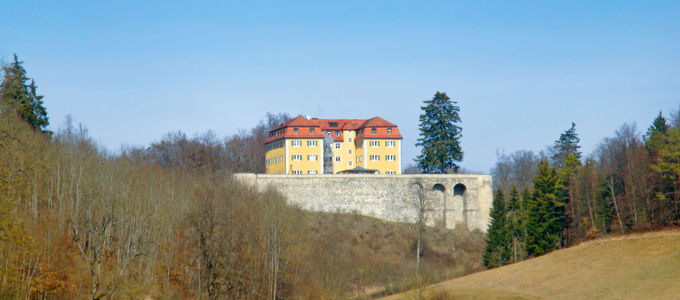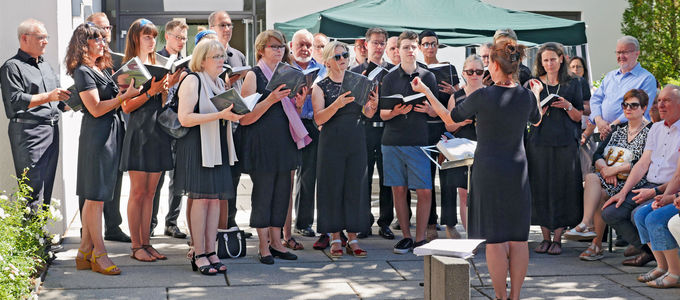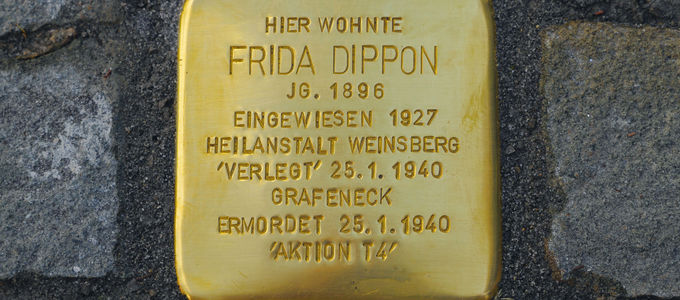A stone of stumbling in front of the church door

In front of the New Apostolic Church in Besigheim, Southern Germany, there is a “stone of stumbling” that commemorates Frida Dippon. She was the wife of the former rector, who was murdered as part of the National Socialists’ euthanasia programme in 1940.
Together with her parents, Frida Dippon—who was born in Großsachsenheim, Württemberg in 1896—was among the first New Apostolic Christians in Besigheim, which today is part of the Heilbronn church district. In 1918 she married Ernst Dippon, the later rector of the Besigheim congregation.
When a church was built in Besigheim at Ulrichstraße 3, the family moved to an apartment in the upper storey of the church building with their two children. Today, the same site is home to a new church building that was erected in the year 2000.
From the clinic to her death
In 1926, Frida Dippon received treatment in what was then a psychiatric clinic in Tübingen, owing to problems with her mental health. A year later, she was admitted to the state-run sanatorium in Weinsberg, where mentally ill patients of the time were more or less housed. From there Frida Dippon was transferred to Grafeneck in the Swabian Jura on 25 January 1940 along with 46 other women—and murdered together with them by poisonous gas on the very day of their arrival.
Established in 1939 at Grafeneck Castle, formerly a residence of the Home Mission, the extermination centre was the first facility where the government tested the systematic killing of human beings with the aid of carbon monoxide gas. In the scope of the “T4 Campaign”, over 10,000 mentally ill patients and disabled people—among them even children and young people—who had been “designated” for termination beforehand in hospitals and homes as so-called “lives not worth living”, were gassed to death there between January and December 1940. The perpetrators of Grafeneck were later deployed in the death camps of Auschwitz-Birkenau, Belzec, Sobibor, and Treblinka.
A warning to never forget
“For us this stone of stumbling is to serve as a daily reminder that we must focus on charity, and fight against discrimination and hatred,” said Dominik Floer, rector of the Besigheim congregation, in his address at the laying of the stumbling stone on 29 July 2019. These “stumbling stones”—a project started in 1992 by artist Gunter Demnig—serve to commemorate people who were persecuted, deported, murdered, or driven to suicide during the National Socialist dictatorship. Over 70,000 stumbling stones—concrete cubes with an inscribed brass plate bearing the name, year of birth, and year of death of the victims—have since been laid throughout Europe, usually in front of the last freely chosen residence of the person concerned.
Since they are conspicuously placed in walking paths, the memorial stones cause passers-by to involuntarily pause, and thus serve as a memorial to ensure that the terrible suffering and injustice perpetrated by the Nazi dictatorship is never forgotten. Naturally, they also function to memorialise the victims of the Nazi period. The first such “stumbling stone” for a sister in faith in Southern Germany was laid in November 2006 in the Stuttgart city quarter of Feuerbach. It commemorates Helene Wöhr, who was a member of the Feuerbach congregation, where she had also been confirmed in the year 1930. Helene Wöhr, whose father was a Jew, was sent to the concentration camp in Riga in 1941 at the age of 27 and murdered there.
There is another such stumbling stone in front of a New Apostolic congregation in Southern Germany, this one at Zeppelinstraße 275 in Friedrichshafen-Fischbach. Laid in September 2013, it commemorates Elsa Hammer, a Jewish citizen born in Göppingen in 1884, who had once lived there (the house where the church building stands today was destroyed in the war). Elsa Hammer was sent to Auschwitz in 1943, where she was murdered that same year.












